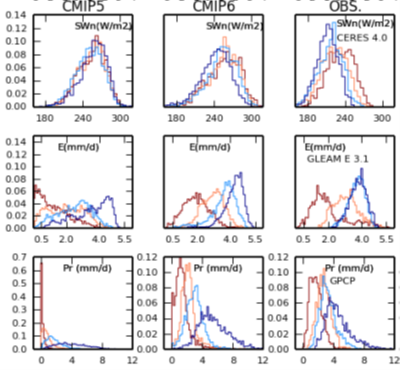ESA CCI Surface Soil Moisture for Evaluation of CMIP6 Models
Key Results
Comparison with ESA CCI soil moisture confirmed improvements to the IPSL CMIP6 climate model
- Coupled models simulate the surface and atmosphere and the interactions between them. Development of coupled models is crucial to improve understanding of the Earth System.
- A model from the Coupled Model Intercomparison Project phase 6 (CMIP6) was evaluated through comparisons with ESA CCI surface soil moisture data (CCI-SSM). The CMIP6 model outperforms the CMIP5 version due to improvements in its hydrological modelling (Cheruy et al., 2020).
- Comparison with CCI-SSM also demonstrated a model evaluation approach and identified potential areas for future development which apply to many of the CMIP6 models.
ESA CCI Climate Modelling User Group (CMUG) members Frederique Cheruy, Agnes Ducharne and Yanfeng Zhao at IPSL evaluated the latest version of their land-atmosphere climate model through comparisons with ESA CCI soil moisture dataset. This is a product created from satellite observations using combined active and passive microwave retrievals of surface soil moisture (Dorigo et al 2017).
Surface-atmosphere coupled models are essential for understanding the Earth System and future climate change. Interactions between the surface and the atmosphere modulate regional climate, they also have impact at the global scale, through mechanisms such as freshwater release into the oceans. Climate hazards (e.g., heat waves, droughts) and their impacts on populations strongly depend on interactions between land and atmosphere and how this evolves with climate change. CMIP6 has provided important input into the recent IPCC report on changes in the physical climate system and thus it is important to measure the progress of these models and identify areas for future evolution.
Figure 1 shows simulations from the CMIP5 and CMIP6 version of the model and observations in each of the three columns respectively. Solar flux is shown on the top row, evaporation on the middle row and precipitation on the bottom row. The CCI-SSM data is used to divide the data into categories each indicated by a different coloured line which represents the distribution of the variable in each soil moisture category. CMIP6 matches the observations more closely than CMIP5 indicating an improvement in the modelling of these three quantities. This is due to improvements in the atmospheric and land surface (hydrology) physics implemented in IPSL-CM6 (Cheruy et al., 2020).

The comparison with CCI-SSM also highlighted the potential for future model development in a number of areas, including:
- Use of surface roughness parameterisations
- Modelling of the evaporation resistance of the bare soil
- Realistic groundwater description
- Improved representation of water freezing/thawing
- Assessment of the impact of soil nitrogen availability
- A new canopy radiative transfer scheme
- Independent tuning for TOA radiation and for the land surface processes
References
Cheruy F., A. Ducharne, F. Hourdin, I. Musat, E. Vignon, G. Gastineau, V. Bastrikov. N. Vuichard, B. Diallo, J.L. Dufresne, J. Ghattas, J.Y. Grandpeix, A. Idelkadi, L. Mellul, F. Maigna, M. nenegoz, C. Ottlé, P. Peylin, F. Wang, Y. Zhao, Improved near surface continental climate in IPSL-CM6A-LR by combined evolutions of atmospheric and land surface physics. Journal of Advances in Modeling Earth System, 12, e2019MS002005, https://doi.org/10.1029/2019MS002005, 2020.
Dorigo, W., Wagner, W., Albergel, C., Albrecht, F., Balsamo, G., Brocca, L., Chung, D., Ertl, M., Forkel, M., Gruber, A., Haas, E., Hamer, P. D., Hirschi, M., Ikonen, J., de Jeu, R., Kidd, R., Lahoz, W., Liu, Y. Y., Miralles, D., Mistelbauer, T., Nicolai-Shaw, N., Parinussa, R., Pratola, C., Reimer, C., van der Schalie, R., Seneviratne, S. I., Smolander, T., & Lecomte, P. (2017). ESA CCI Soil Moisture for improved Earth system understanding: State-of-the art and future directions. Remote Sensing of Environment.
About the author

This article was produced in 2022 by IPSL authors Frederique Cheruy, Agnes Ducharne, and Yanfeng Zhao.

